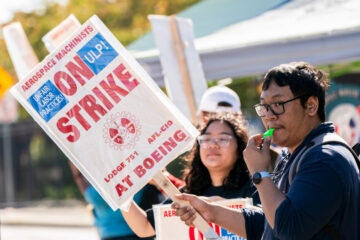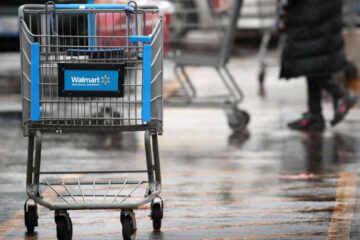Despite cooling prices, persistent food inflation is still weighing heavily on the wallets of Americans. TheStreet’s Conway Gittens took to the streets of New York City to gauge the impact of higher prices on both consumers and restaurant owners, including a local chef grappling with higher prices while still maintaining quality and affordability.
Full Video Transcript Below:
CONWAY GITTENS: Inflation is coming down, but food inflation is still a problem. The cost of eating out is 4% higher than it was a year ago. While eating in is up less than a full percent. So we’re out here asking people how is food inflation impacting their dining habits.
KIM: Well, we used to really enjoy going out to eat probably too much.
ARCHIBALD: I don’t go out to eat as often as I used to.
CHRISTINA: I’ve spent as much as 40 bucks for something healthy.
FRANK: We can’t go out to eat too much. We have two kids, so we stay. Very rarely do we go out anymore.
ELIANA: Yesterday, I got a salad. It was like $15, which is ridiculous to spend every single day.
MARISON: I don’t really spend a lot of money outside because it’s really expensive outside.
ANDREW: Life is short, so you’ve got to pay the extra money. It’s just the vig for living in New York.
CONWAY GITTENS: And some diners are noticing not only are restaurants going up on their prices, they are also cutting back on the portions.
FRANK: Portion sizes are down. Prices are up.
ARCHIBALD: One thing I noticed is that the quantity that you get, I’m a big eater. The quantity is smaller than it used to be.
STEPHANIE: I just remember like years ago, I would order something like an appetizer. An appetizer would be enough to feed, like, the whole entire table. Now it’s like an appetizer is so small. It’s like for one or two people.
MARISON: You’re not getting what you’re actually paying for, especially because everything is so expensive now.
ANDREW: Charge the same amount, give you less, or keep the same amount. Charge you more. But that’s capitalism. What are you going to do.
CONWAY GITTENS: But food prices aren’t just hurting the wallets of consumers as the people serving up the food are feeling the pinch as well. We went to Charles Pan Fried Chicken here in New York City to speak with head Chef Quie Slobert about the toll rising food prices are taking on the business end.
CHEF QUIE: So as of right now, food prices are skyrocketing. We are Charles Pan Fried Chicken. We are known for chicken and that is like a roller coaster. It started off high and then it goes high and it comes back down to being high and it goes even higher. Affected me how? Because we are in the middle of Harlem. This is 145th Street. We do not want to raise the prices too much. We want to make sure we feed the average family. So we just have to cut corners everywhere else. And that’s by meeting materials. And like Con Edison makes sure we cut the lights off like something as simple as that tissue, something simple as that. But we do not skip when it comes to the food and the ingredients. We keep it the same way. It affects everybody. Labor, we are very cautious on how we do labor and that’s where we control the most. We can’t control the rent, but we can control the labor. We can control the food cost, meaning like not ordering so much. And we actually can control the supplies we purchase. So being mindful on the other stuff that we can control because food prices are killing us.
CONWAY GITTENS: How have you been forced to tweak the menu in order to prevent you from having to raise price?
CHEF QUIE: Any high priced items we will still provide, like lamb chops. I would love to have jerk lamb on our table every day, but we just can’t have it out because the normal person won’t come in and buy a lamb chop for $7. We work in family all around us. This is actually the community. I can’t sell you one lamb chop for $7 and that’s going to fill up who. So that’s the only tweak. So to say we did if you want to say tweak.
CONWAY GITTENS: So you have economies of scale. Because you have three restaurants.
CHEF QUIE: Yes, we do.
CONWAY GITTENS: So you’re able to go to your suppliers and be like, hey, I’m supplying three restaurants here. Give me the best price you got.
CHEF QUIE: And this is what it is. This is what happened. You have. Starbucks you have McDonald’s, you have places like that that’s all over. So that’s what they do. And they get the lowest price of everything. So that’s why the food is so cheap. Now, mind you, we are Harlem. We have three locations only. So I’m using that same marketing manager style to try to get a better price on everything. Thank God for the community. They are buying our food. So we have that buying power right now. But it’s not as much. It’s not as much. If you go to a Popeyes, they’re all over. If you go to KFC, they’re all over. So they’re getting a better price than I’m getting on chicken, hands down. But right now, we’re scaling up. We’re buying more. So I’m using our little buying power to try to get the best deal.
CONWAY GITTENS: So you mentioned McDonald’s and Popeyes. And even though you’re not in the same segment of the restaurant business or the food business when they go low, does that put pressure on you, on restaurants like you to match these low prices.
CHEF QUIE: Our prices are set for my community. I mean, you come in here, we have the lowest price in Harlem when it comes to the plates, lowest price. But we’re even lower than that $18. You get three pieces of chicken, two sides and a cornbread. We went to a $10 combo special classic. Not because McDonald’s, not because of what’s going on. It’s because we want to make sure we feed our community because not everybody could afford it. So it was no competition. When they do, they fight out of meals because you’re getting real food here.
CONWAY GITTENS: So you mentioned little tweaks on the menu. I’m wondering in the overall business model, have you had to make other changes. Maybe you had to switch to a different kind of container or a cheaper set of utensils or it’s not just the food inflation that’s hitting you, you’re getting hit from all these other places as well.
CHEF QUIE: Yes when it comes to the clam fields, it was a month long debate on what we’re going to do when it comes the cost of goods. We have the cups. We have the biodegradable of this, we have this, we have that. We have paper, we have plastic. Honestly, if we went all plastic, it would have been way cheaper, but bad for the community, bad for the environment. So we actually have the biodegradable clam bowls. We actually have paper bags what I mean. Try to give back the little two cents that we spend more will help our world. I know I grew up watching Captain Planet, so don’t hurt me. He was my hero. So we actually spent just a little extra because in the long term, it’s better. You go home, you get a cheap fork, it breaks, it’s horrible. You get a box that just bends in and gets all watery. You’re not going to like it.
So it’s a juggle when it comes to it. So we did the best that we could and got the best prices that we can. So we keep it good. We try to keep the quality up there. What’s hurting us – that’s what’s hurting us. Rent that’s what’s hurting us. But those things you can’t really change. I was born in Harlem. I was born in poverty. I’m used to being tight. My mom made it. She had three kids, one job. She made it happen. And we’re making it happen. Now So every dollar counts. Everybody that come through these doors and buys something amazing. Thank you. Because as you’re seeing these questions, I wish I could tell you a secret, which I tell you a trade. No, we are living check by check in that sense, every that one person, I don’t care what she buy. I thank her for walking through those doors.


